
Yes, you can provided elders can walk for 2-3 hours and climb 150+ steps.
53,669 views
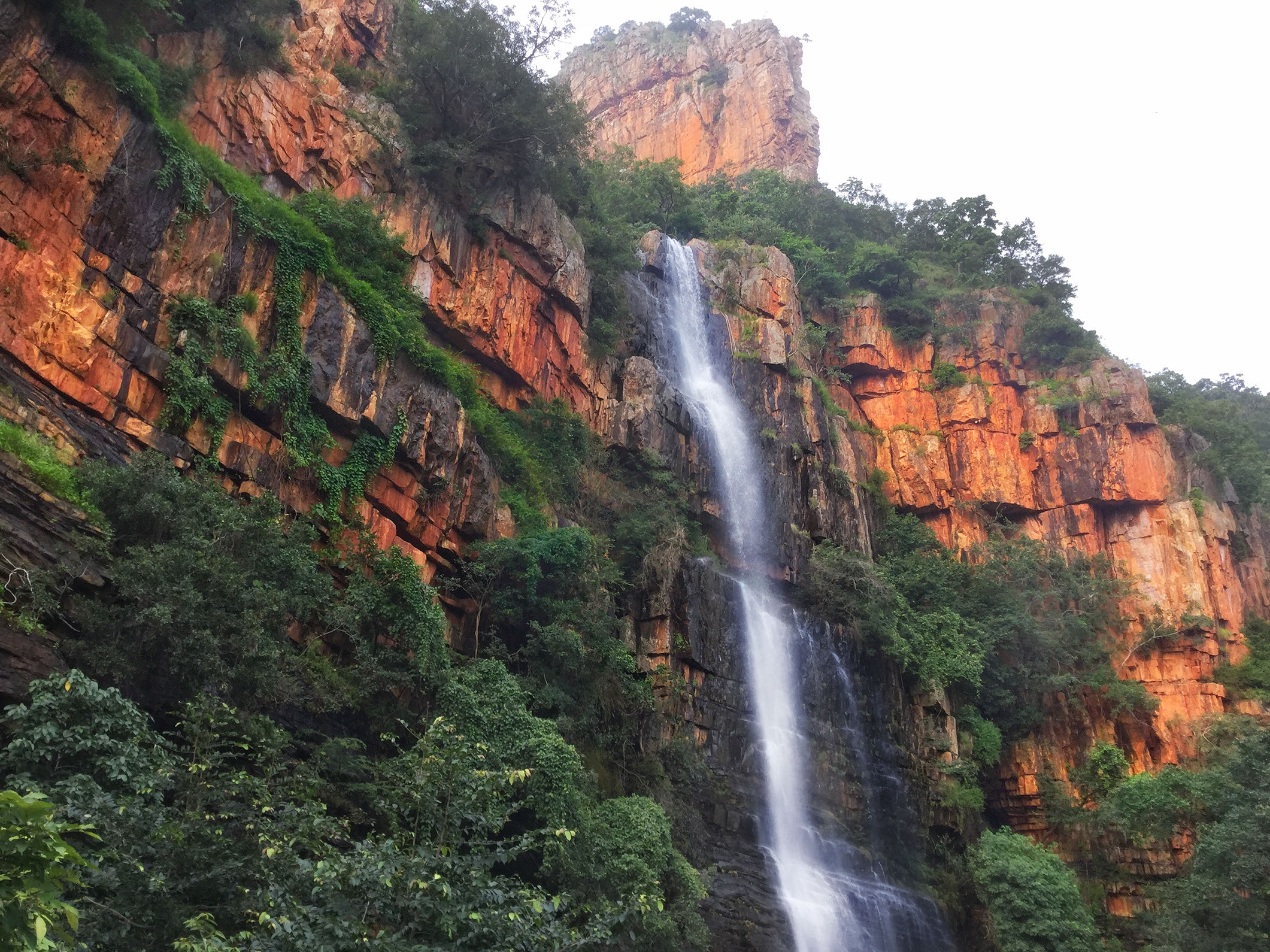
Travelling after a long forced pause is always liberating. Covid had literally brought our lives to a standstill and finally there was some respite in October. We ventured out to less known locations in Andhra Pradesh, hoping to get our dose of the outdoors while remaining ‘safe’ from Covid. Ahobilam Temple inside Ahobilam Forest was the perfect pilgrimage getaway to enjoy nature and adventure while being grateful for life.
We had just finished the first leg of our trip to the Canyon of Gandikota. I was thrilled as the trip was turning out to be exactly what I was looking for, less tourists and nature at its best.
We continued our journey from Gandikota and reached a small town of Nandyal, which is surrounded by historical pilgrimage sites. Usually, the town is buzzing with the devotees, but due to the Covid situation it bore a deserted look with almost empty hotels and all establishments shutting shop by 7 pm. We got great deals with accommodation at Hotel DR Indraaprasthaa in Nandyal through Agoda website. It was a newly opened and the best hotel in town with large, spacious rooms and posh interiors for almost half the price. This was the impact of Covid on establishments dependent on tourism.
Apart from the rooms provided by the temple trust, there are not many hotels in Ahobilam. It is common for visitors to book a hotel in Nandyal or Kadapa and then travel to Ahobilam during the day. Ahobilam is 60 km from Nandyal, while Kadapa is 100 km away.
From here we headed to Ahobilam Narasimha Temple, a holy and spiritual place amidst the majestic hills of the Eastern Ghats. Ahobilam is one of the hidden places to visit in South India during monsoon. It is a center of worship of the lion-headed avatar of Lord Vishnu, Narasimha. There are several temples devoted to Narasimha Swamy nestled inside the picturesque Nallamala forest range, also known as Ahobilam Forest. "Aho bilam" means beautiful caves and some of these temples are located inside the caves. Also, the demigods here praised Narasimha Swamy as 'ahobala' meaning "the great strength". It is believed that no deity is supreme than the nine deities of Narasimha Swamy residing at the scared abode of Ahobilam (Ahobilam Caves).
The inscriptions dated as early as 14th and 15th century suggest that the emperors of Vijaynagara built the Narasimha temples at each site. They were destroyed by the Mughals during the 16th century and restored back by various dynasties. The entire structure of Ahobilam temples is an amalgam of work by various dynasties over 5 centuries.
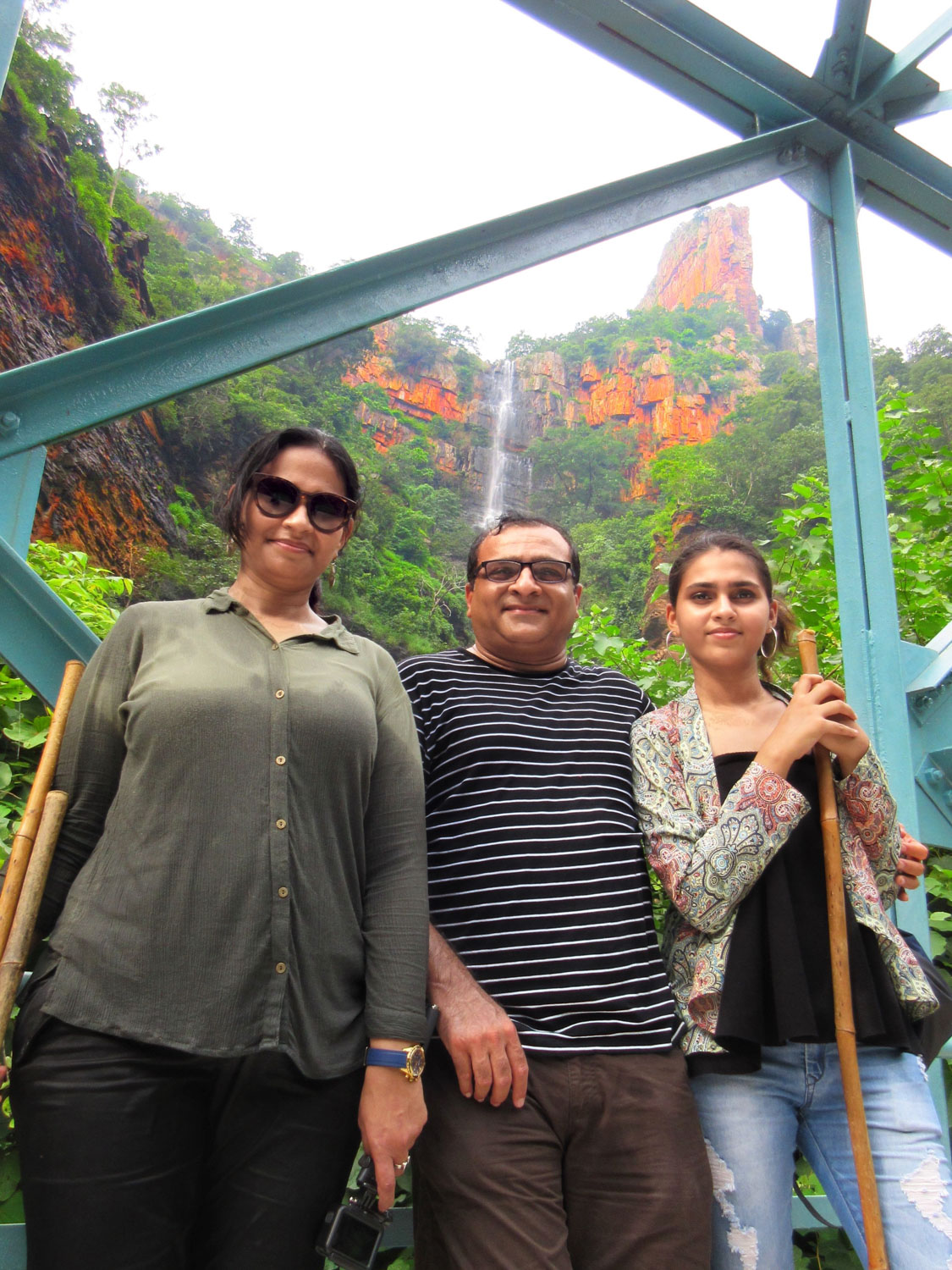
Trekking through Upper Ahobilam Temple with family
The region is divided into Lower Ahobilam and Upper Ahobilam. Ahobilam temple location is divided into two distinct places. Totally, there are 9 temples devoted to 9 different avatars of Narasimha Swamy. Of these, there are 4 each located at Lower Ahobilam and Upper Ahobilam and one in between them. Barring two of them at Lower Ahobilam and one on the way, the path to the other 6 temples treat you to adventurous treks and a bumpy and scary jeep ride through a treacherous path inside the dense forest. There are many things to do in Ahobilam depending on your interest level.
We first drove to Lower Ahobilam from where you can hire the jeep to reach "Pavana" and "Bhargava" temples deep inside the Ahobilam forest. Unfortunately, due to heavy downpour in the past few weeks prior to our arrival, there were landslides and water logging which obstructed the entry of the jeeps. So, we had no choice but to skip these temples; one more reason for a revisit. The first thing we did here was to hire a guide as it is a MUST if you really want to enjoy and explore everything followed by a visit to "Yogananda" and "Chatravata" Narasimha temples.
"Yogananda Narasimha" temple is named after Narasimha Swamy who rested here in a yogic posture with his legs crossed. It is also believed that the deity here rules planet Saturn (Shani). "Chatravata Narasimha" is the tallest and most handsome among all the 9 deities of the Nava Narasimha. It is believed that two Gandharvas (named HaHa and HooHoo) entertained the Lord here with their divine music. Hence, the devotees here perform before the deity with music to seek blessings. It is also a belief that the Lord grants mastery in music and arts to the devotees.
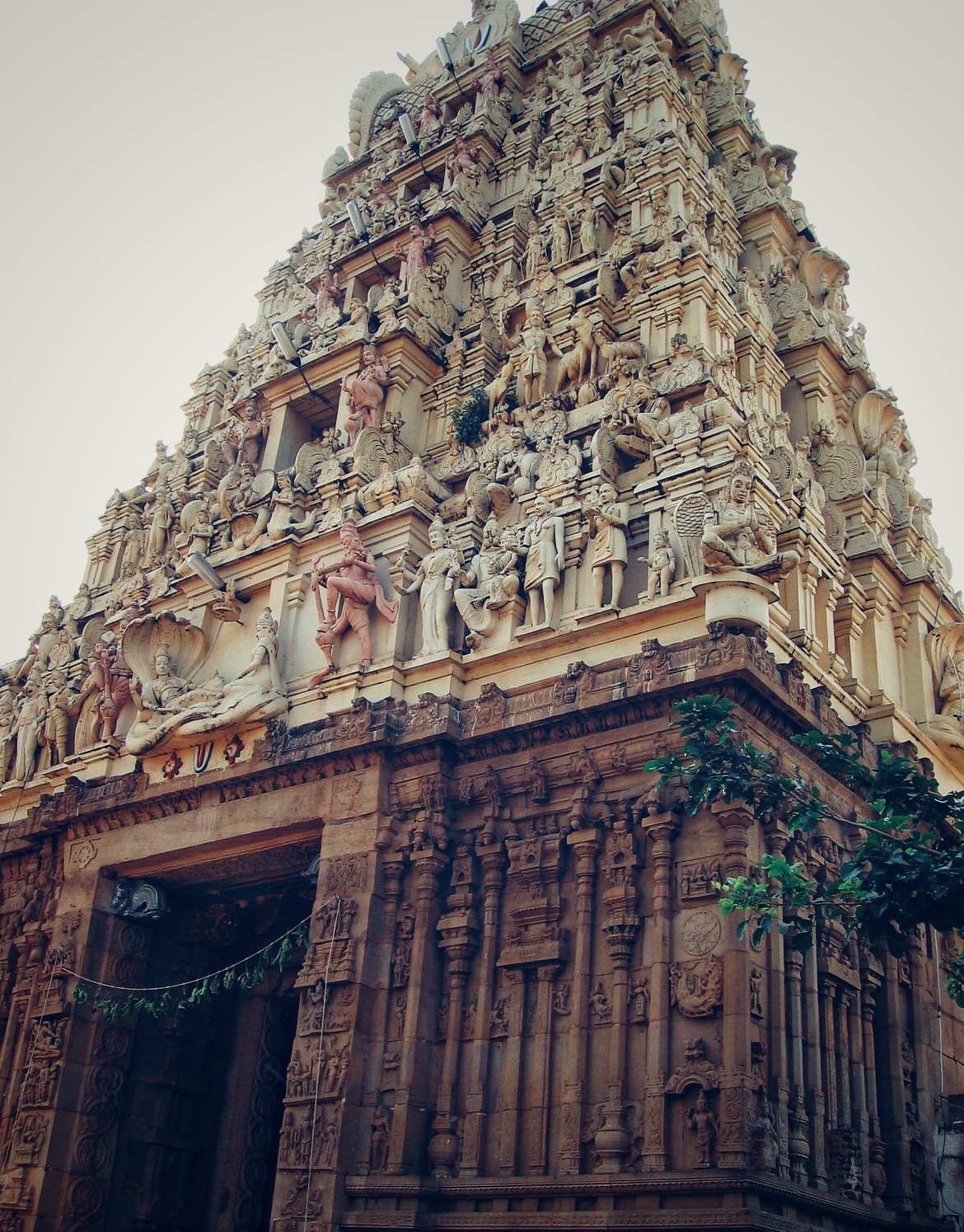
The ancient temple of Chatravat Narsimha Swamy at Lower Ahobilam
Two exquisite temples done, now its time to drive to Upper Ahobilam Temple where a tough adventurous trek awaited us. It was an 8-kilometer uphill drive through Ahobilam forest with lush green surroundings. A jaw dropping, colossal, carved out boulder with red stone and a series of waterfalls welcome you at Upper Ahobilam temple. The massive entrance with natural fading colors of red stone in the backdrop of lush green landscape is very impressive. This builds your anticipation for something very exciting. Our guide Krishna had already prepared us for a tough trek, but we hit a roadblock immediately, we were all very hungry. Krishna escorted us to Brahmana Nitya Annadana Satram where they serve delicious and "satvik" food to 500 odd devotees, daily. We had a 40-minute wait for our turn, but the food was well worth it. The food is served free of charge but you are welcome to donate money to the trust so that nobody goes hungry.
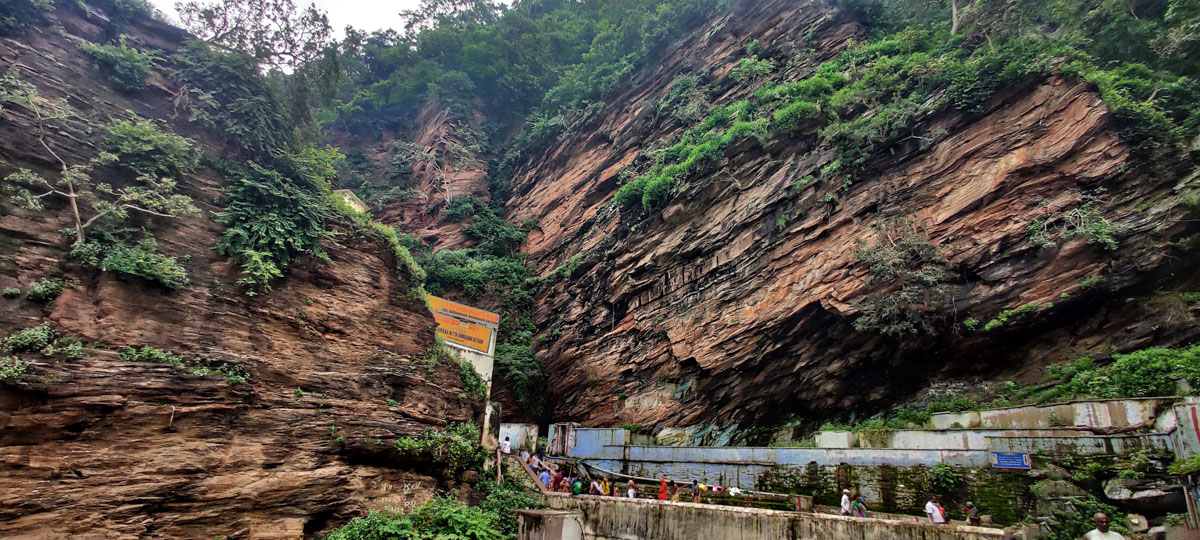
Welcome to Ahobilam: A large cutout boulder is your entry to the grand theatre
After a sumptuous meal, we were all set for the famous trek! We had lost time waiting for lunch, hence needed to pace up before the most important of all the Ahobilam temples closes down. These temples are not open all the time so, it is advisable to keep a check with Ahobilam temple timings. The latest information and Ahobilam temple history can be found on Ahobilam temple website. We trekked through massive boulders and the first sight was a beautiful waterfall up the hills. We couldn't resist stopping for pictures while Krishna was nudging us forward promising better sights ahead.
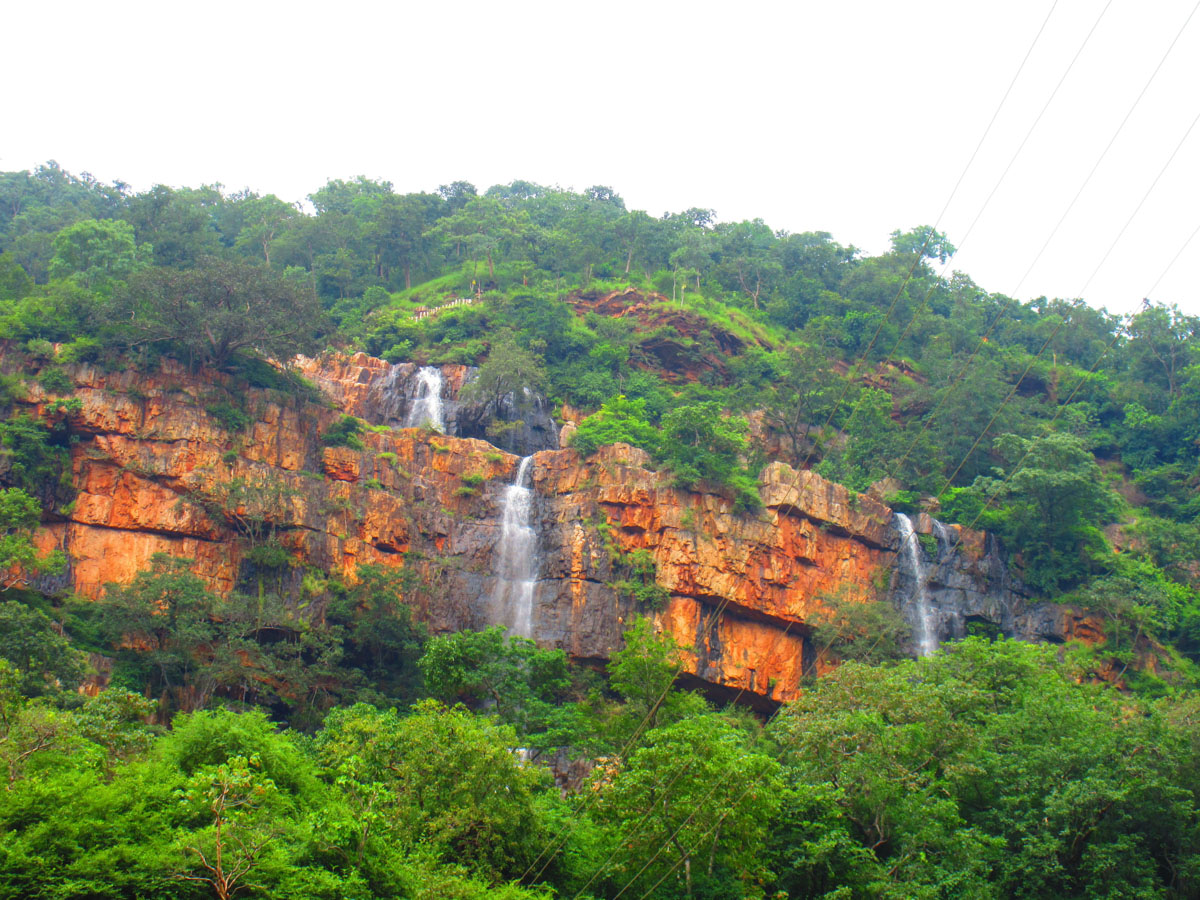
The beautiful sight of cascaded waterfall atop the hills of Eastern Ghats at Upper Ahobilam temple
Our first stop was at Yeguva Ahobila Narasimha Swamy Temple, the main temple that is also the earliest among all 9 temples. The sanctum of the temple is inside a cave and it is believed that the idol here is a self-manifest (Swayambhu). The form of Narasimha is fierce (Ugra) and is in the Sukhasana pose. The Lord had killed the demon Hiranyakashyapu so, it is shown as the demon lying across his thigh and his hands holding the legs and head while tearing apart his chest to kill him. A very dramatic scene, indeed! On the other side is seen Prahalada with folded hands offering his prayers to the Lord who was sent to save him from the demon King (his father) Hiranyakashyapu. Ahobilam temple history is quite intriguing.
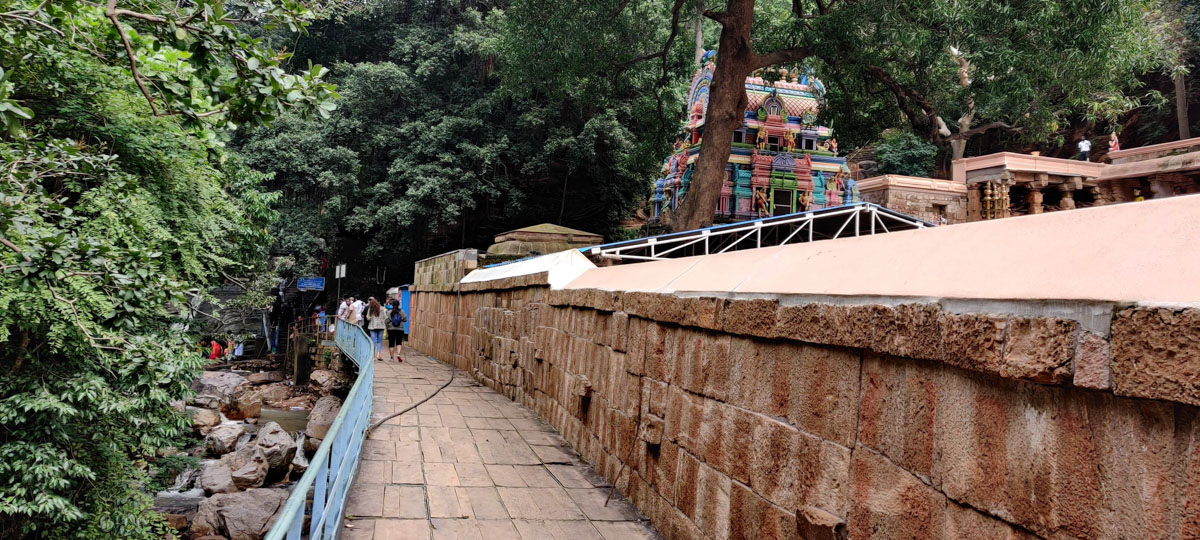
The main shrine of Ahobilam temple, Yeguva Ahobila Narasimha Swamy Temple on the banks of Bhavanasini River
Next, we had to cross the River Bhavansini for the first time and begin our 3.5-kilometer trek atop the hills to Jwala Narasimha Temple. The beautiful sight of the gushing river can be witnessed only during the 3-4 months of monsoon and post-monsoon. The knee-deep water with a heavy current formed many beautiful waterfalls on the way. There is rope support to cross the river at few points where the water level is rather high with the current pushing you forward. This was the prelude to what lay ahead; rugged narrow paths, steep hills and much more! We were all pumped for this challenging trek. Further ahead, we had to crisscross the river several times carefully hopping over uneven and sharp rocks (some of them wobbling) wadding through the river flowing downstream. The scenery around us was so breathtaking that we repeatedly stopped to take photos with Krishna coaxing us to move ahead while helping us navigate our way through the river. I doubt we would have returned in one piece if not for our excellent guide. This first time experience was nerve wrecking but exhilarating.
A 4-hour adventurous trek along the River Bhavansini to Jwala Narasimha Ahobilam Temple
Finally, we reached the base and we thought we made it as Krishna, for the first time, asked us to relax. We took a small detour to a bridge. To our surprise, we saw a stunning panoramic view of the Ahobilam forest with a giant Ahobilam waterfall and Ugra Stambh at the peak of the mountain. While relaxing, we were scanning the area for Jwala Narasimha Temple, the reason for this tough trek. Laughingly, Krishna pointed towards the Ahobilam waterfalls and its then that we discovered we were only halfway there. With 450 steps to make it to the top, 100 of which are quite steep at almost 60% altitude, we had a challenging path ahead.
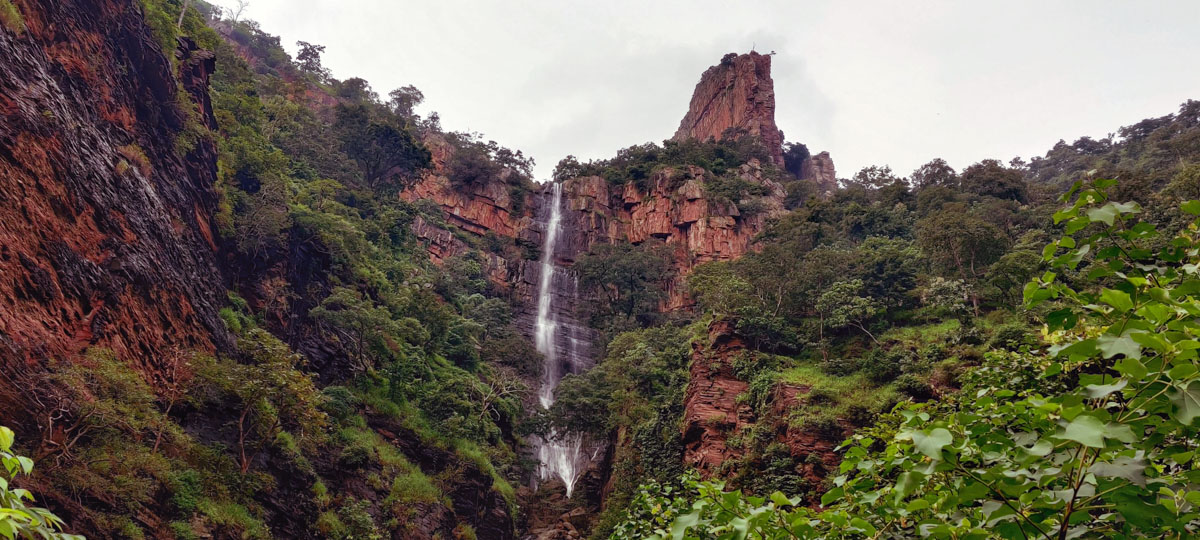
Breathtaking view of the giant Ahobilam waterfalls and Ugra Stambh
We started our climb through well-laid stairs, relieved that we didnt have to navigate through rocks and the gushing river. The moment we started ascending the view became clear and we could see the dense forest of Nallamala Range in all its glory thanks to heavy rain this season. Krishna informed us that everything here is dry and the giant Ahobilam waterfall ceases to exist barring 3-4 months in a year. I could imagine the depressing sight and felt lucky to have visited at the right time of the year. As we were coming closer to the top, the increasing sounds of the waterfall heightened our excitement. When we reached the top, we discovered that the way to the temple is through Ahobilam cave which is open on one side and lined on the other side by the gigantic vigorously cascading waterfall. We were completely drenched while passing through, but it was thrilling.
Stunning view of Nallamala forest range and giant Ahobilam waterfalls as you climb atop Jwala Narasimga Temple at 2,800 feet altitude
The temple looks more beautiful once we reach there after passing through the tunnel and experiencing Ahobilam waterfall at such close proximity. We never imagined this experience when we saw the waterfall from below the hill. You will find a signboard "Way to Ugra Stambh" after reaching the top. This is another adrenaline pumping trek and is considered to be the toughest of all. It takes at least 3 hours round trip to go over Ugra Stambh from Jwala Narasimha Temple. It is believed to be the pillar from where Lord Narasimha appeared to kill the demon king Hiranyakashyapu. It is a steep 80-degree climb without steps and through uneven rocks with the help of a rope, a thorough mountaineering thrill. We didnt have enough time or appropriate gear so we decided to pass this stretch.
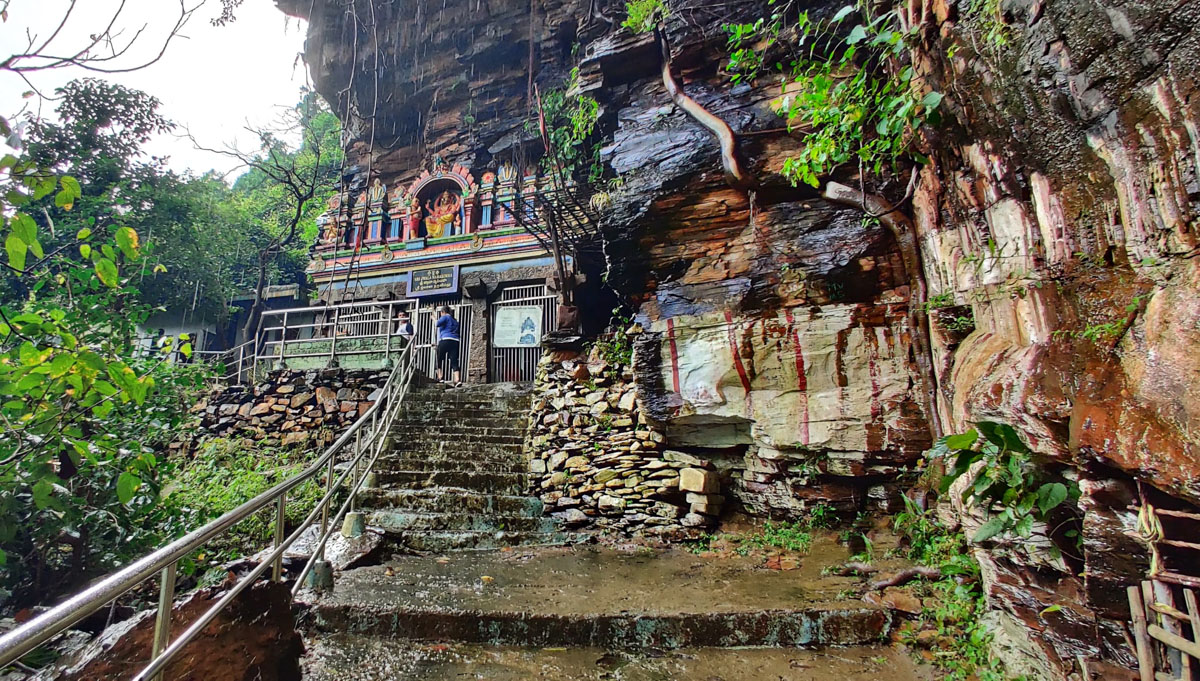
Jwala Narasimha Swamy Temple nestled in the dense Ahobilam forest of Nallamala and beneath Ugra Stambh atop Meru mountain
The Jwala Narasimha idol is quite overwhelming with the posture of 8 arms, 2 of them holding Hiranyakashyapu on the lap and two arms tearing open its chest, two arms wearing the intestine as a garland and the remaining two arms holding Shankh and Chakra. The local Chenchu tribe manages the temple until date as they treat the Lord as their "son-in-law". The devotees are allowed to offer meat to Jwala Narasimha Swamy every Saturday and co-incidentally we were there on Saturday. I would recommend spending some time here and exploring the backside of the temple to witness a portrait view of the giant waterfall and soak in the beautiful sights and sounds. Without Krishna, we wouldn't have discovered this location and missed the amazing view.
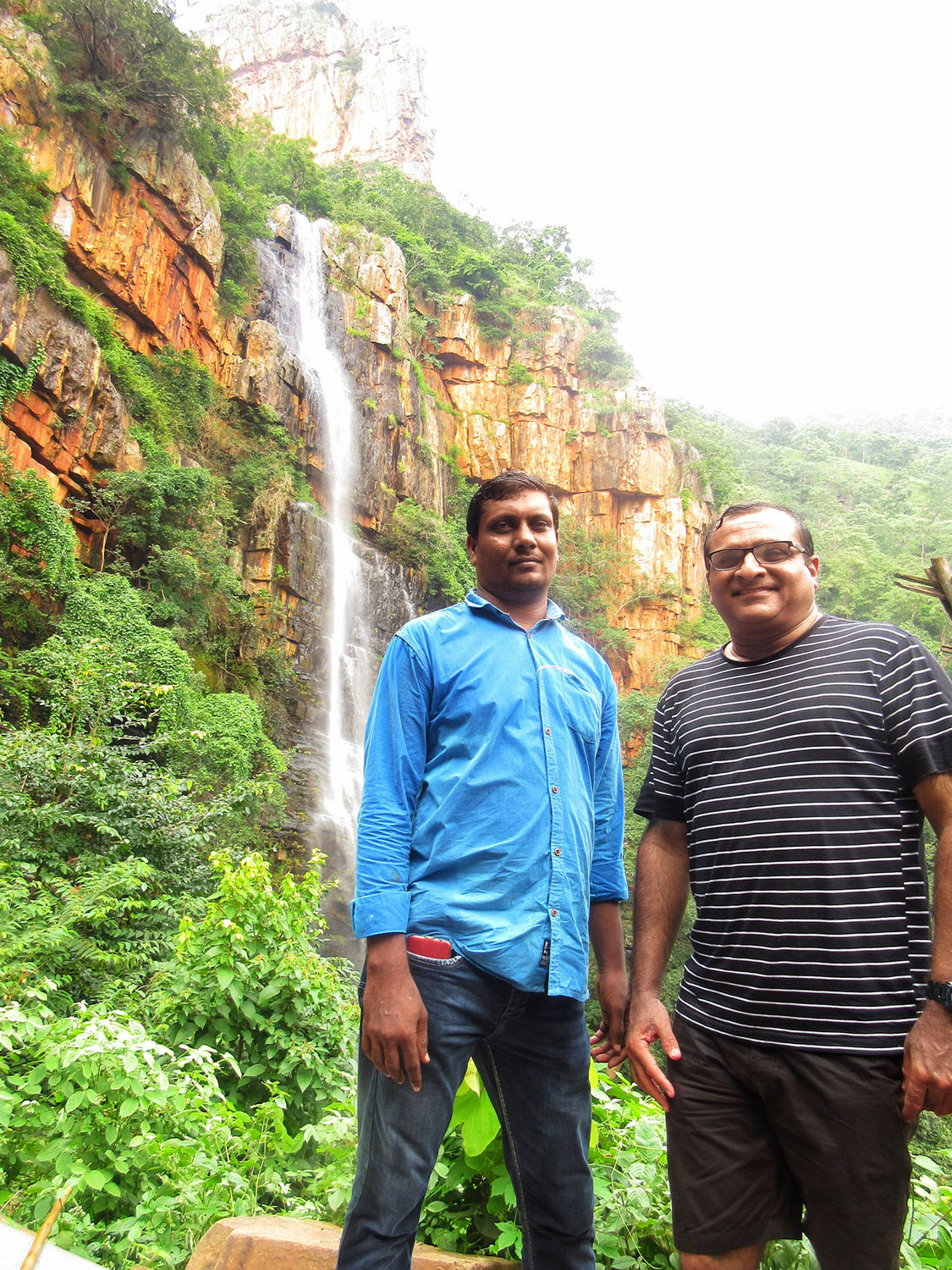
Posing with Krishan behind the Jwala Narasimha Temple in the backdrop of the beautiful Ahobilam waterfall
We wandered around until the Ahobilam temple closed and indulged in the serene beauty. It was time to go back navigating through the treacherous path along the River Bhavanasini. We had to cover two more temples on our return, Varaha Narasimha and Malola Narasimha. The portrait of the deity has the face of a wild boar depicting anger (Krodha or Varaha) and the Lord is seen with his consort Chenchu Lakshmi. Chenchu Lakshmi from the local tribe helped Lord Brahma to pacify and calm down Lord Narasimha after he killed Hiranyakashyapu. She brought down Lord's anger and hence, she is known as "Malolan" - a Shanthi Swaroop (peace keeper).
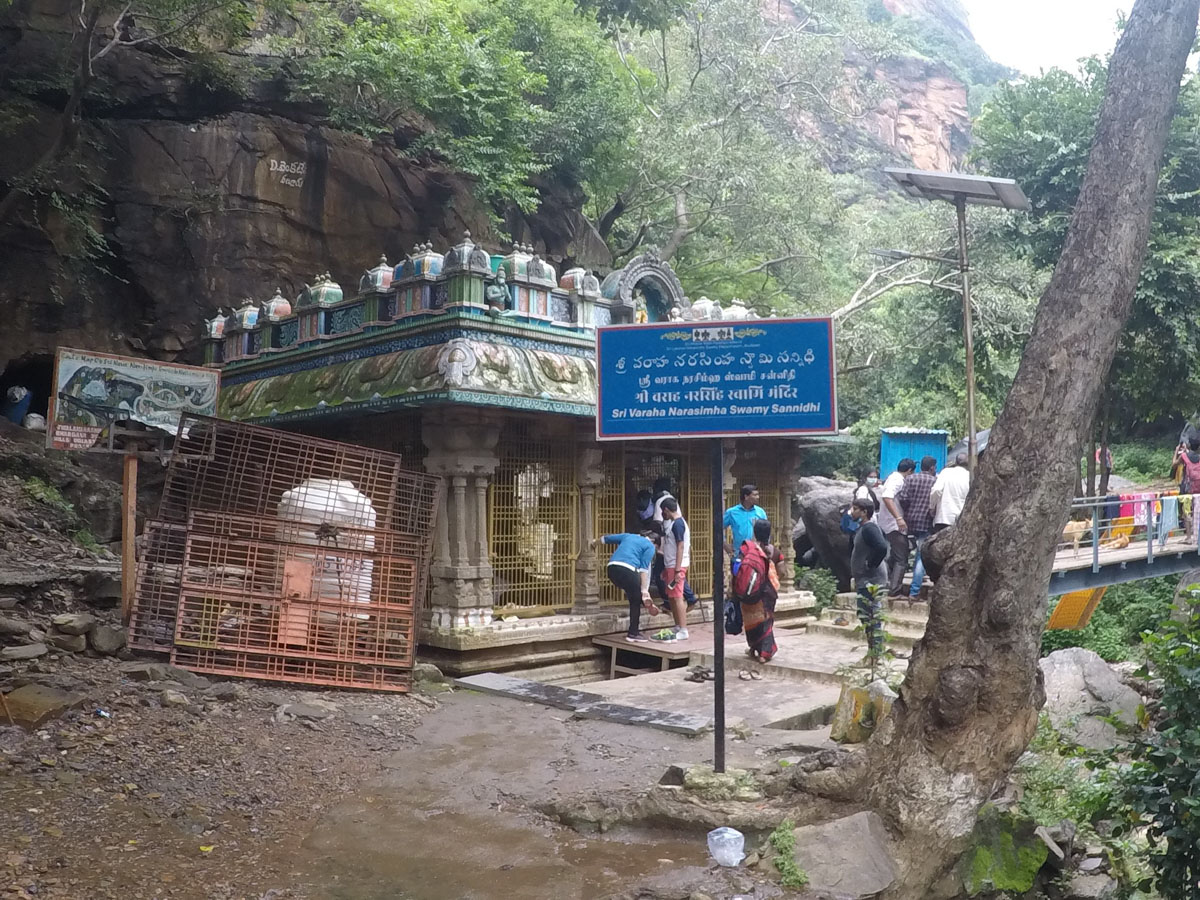
Varaha Narasimha Swamy Temple, one of the Nava Narasimha Temples in Ahobilam.
It's time to handover the sticks we had borrowed for trekking, take the final blessings from Ahobila Narasimha Swamy and thank Krishna for such a fulfilling experience. We then headed back to Nandyal to rest and rejuvenate before venturing to other destinations the next day.
If you need Krishna's services, feel free to call him on his mobile +91 90100 43193. He is fluent in Tamil and Telugu, and can also speak a bit of Kannada and English. You can count on him to go the extra mile to ensure you have an incredible experience at Ahobilam.
Paruveta Utsavam is a significant festival celebrated in Ahobilam. This festival is deeply rooted in the religious and cultural traditions of Ahobilam and the devotion to Lord Narasimha.
According to the legend, Lord Narasimha, after vanquishing the demon Hiranyakashipu, continued his fierce form and went into the forest (Paruveta) for hunting (Utsavam). The Paruveta Utsavam commemorates this divine hunting expedition. With their reverence for Ahobila Narasimha as their brother-in-law, the Chenchu tribes invite him to their home to celebrate Makar Sankranti.
The celebration begins with a grand procession carrying Lord Narasimha's deity from the sanctum sanctorum of the temple to 32 tribal hamlets within the Nallamala Forest. Devotees accompany the deity, singing hymns and bhajans. The celebration continues for 'mandala' (40 days). A symbolic mock hunting ritual is performed, where priests and devotees re-enact the divine hunt. This ritual is a reenactment of Lord Narasimha's hunting in the forest, symbolizing the destruction of evil and the protection of dharma.
Paruveta Utsavam is not only a religious event but also a cultural celebration in Ahobilam. It brings together people from religious communities including muslims, enhancing the communal harmony and cultural heritage of the region. The festival is a vibrant display of traditional music, dance, and local customs, making it a unique and cherished event.
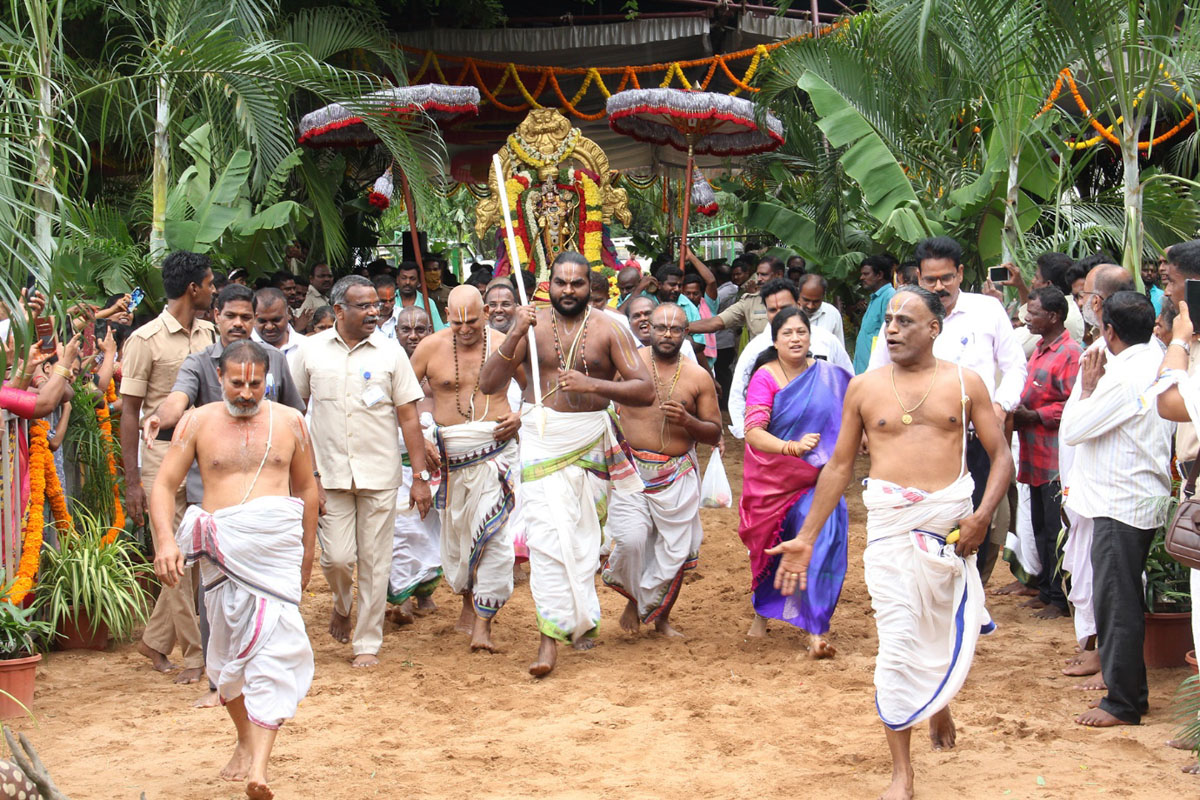
Vibrant celebration of Paruveta Utsavam in Ahobilam (image credit: RSP network)
Ahobilam, a hidden gem in Andhra Pradesh, is suddenly making headlines! The festival gained significant recognition this year in 2024 when both the Andhra Pradesh and Telangana governments declared it a state festival. The festival also holds historical importance, linked to the powerful Vijayanagara dynasty.
Now, there's even bigger news! Efforts are underway to get the festival a UNESCO Intangible Cultural Heritage tag. This would put Ahobilam on the global map and attract travelers seeking authentic cultural experiences.
If you're looking for a festival that reflects the rich heritage of India, Ahobilam's "Paruveta Utsavam" is a must visit!
The next morning we visited the Mahanandi Devasthanam located about 15 kilometers from Nandyal, surrounded by forest and east of Nallamala Hills. There are 9 Nandi shrines known as "Nava Nandulu" in the region and Mahanandi is one of them. This temple dates back almost 1,500 years. The main temple was constructed during Chalukyas dynasty and then it was renovated and rebuilt several times by different dynasties. Mahanandi Devasthanam is surrounded by water ponds (holy tanks) with the bigger and sacred of them located inside the main temple. The sacred pond (Mahanandi Koneru) has a constant flow of water irrespective of the season and water scarcity. The water continuously comes out from the mouth of "Nandi" and flows into the pool, which is a mystery until date. The water remains crystal clear irrespective of the numerous devotees taking a holy dip inside the pond.
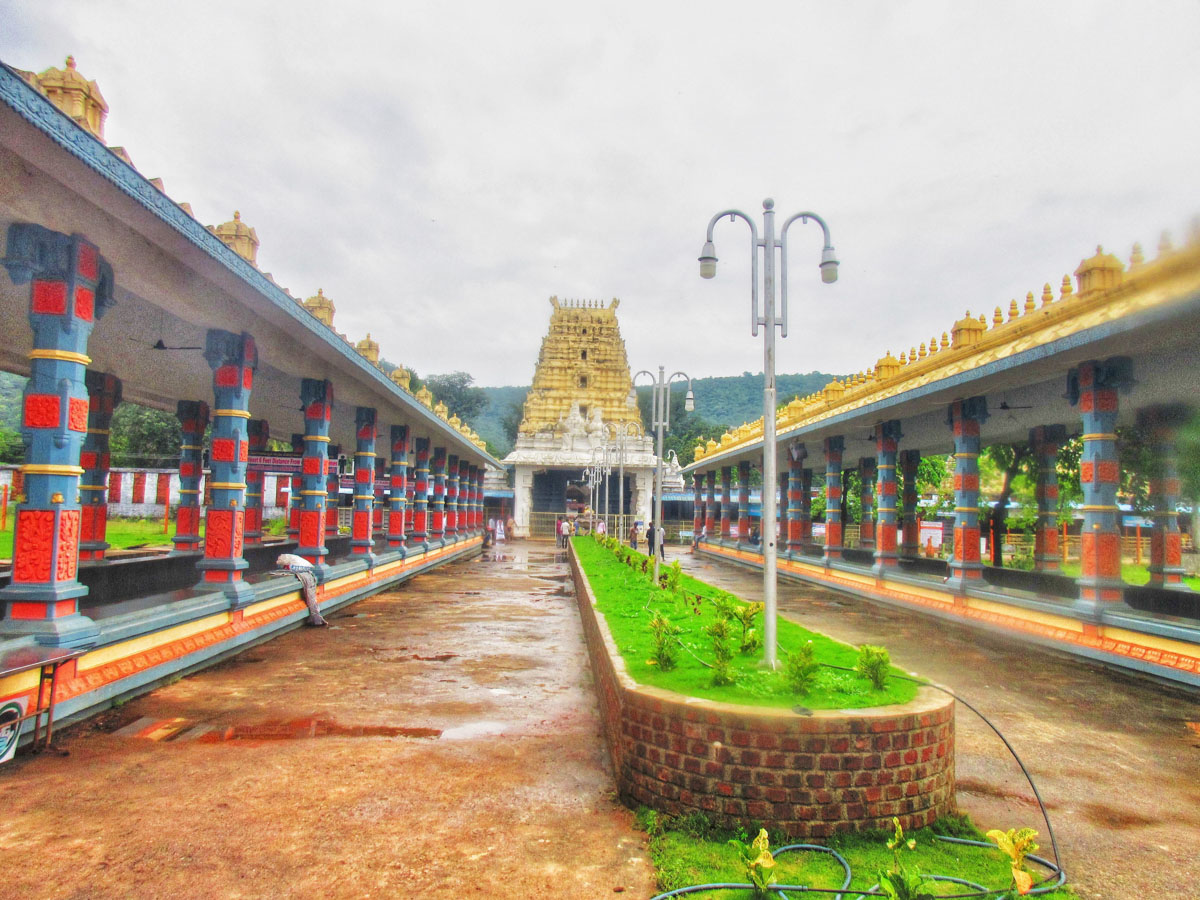
Gopuram of Mahanandi Devasthanam located over central sanctum was built in Badami Chalukyan style of architecture
Our next and final destination of the trip was Belum Caves, one of the largest and longest caves in India. Belum caves history suggests that they went unnoticed for several thousands of years until an expedition by British geologist Robert Foote in 1884 and later by a German geologist Herbert Daniel Gebauer in 1983. There are indications that Jain and Buddhist monks used the caves for meditation few centuries ago. Many Buddhist relics were found inside the caves during the German expedition. Andhra Pradesh Tourism Development Corporation (APTDC) eventually took up the maintenance in 1999 and the caves became a famous tourist place later on. It takes about 2 hours to explore each section of the cave with the help of a knowledgeable guide.Unfortunately, we went there after the monsoon, not the best time to visit Belum caves. Almost 80% of the caves were flooded with water and mud making it almost difficult to navigate in a suffocating environment. The authorities have lit up various sections to make it look beautiful, although I believe that exaggeration of lighting has killed the natural look of millions of years of limestone karst formation. I lost balance and skidded flat at one point while going down the stairs due to slippery mud and lack of lighting and almost broke my ribs. Eventually, we decided to terminate the cave tour, as it was not safe. Check the reviews and latest updates on Belum Caves before your visit.
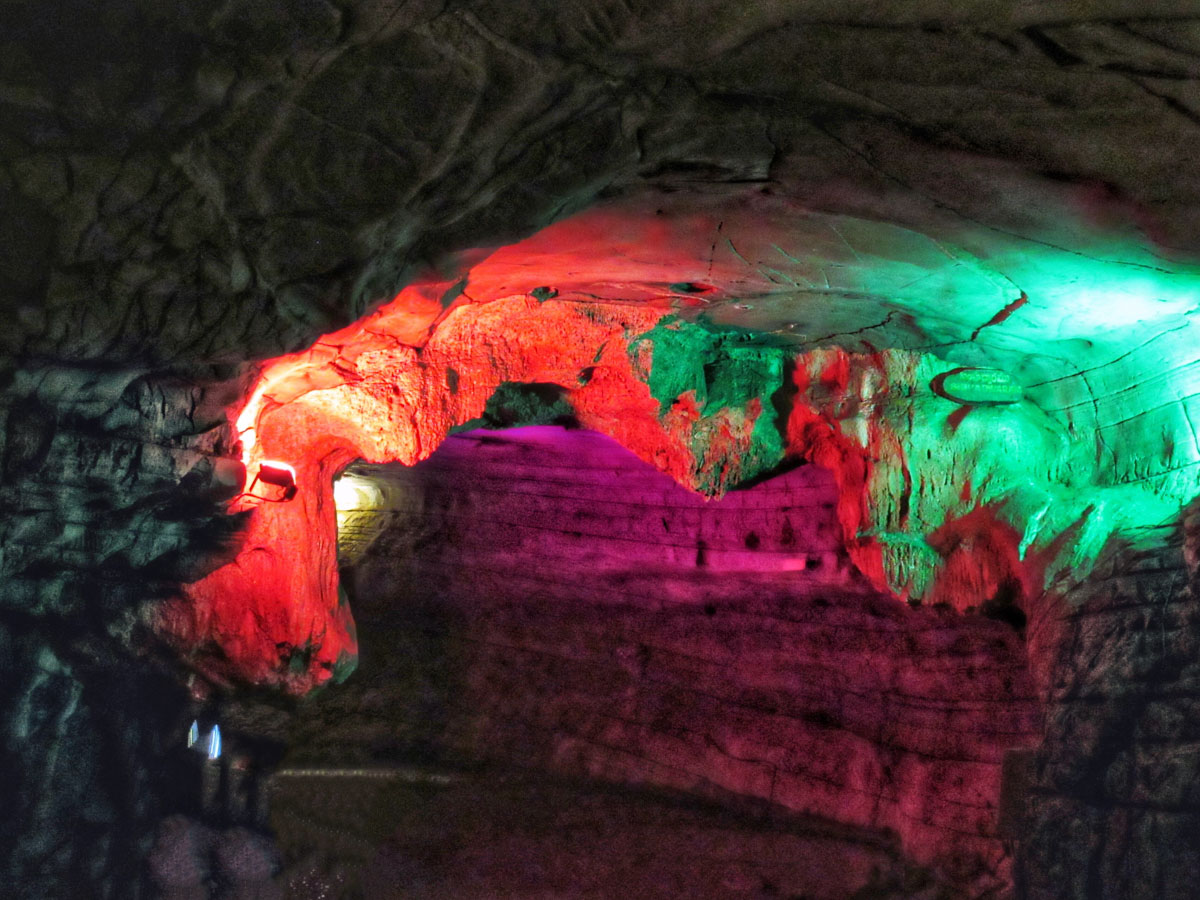
Pillidwaram, also known as "Cats gate". It is a natural arch in the shape of a Lion's head.
Our guide informed us that the best time to visit Belum Caves is February and March when the water is completely dry, before peak summer. This was a trip where we discovered a lot with a lot left to explore. We need some motivation to revisit the place and complete the remaining adventure of two Narasimha Swamy temples located deep inside the dense Ahobilam forest.
With 450 steps to make it to the top, 100 of which are quite steep at almost 60% altitude, we had a challenging path ahead.
Ahobilam is located in Kurnool district of Andhra Pradesh.
The trust provides basic accommodation at Upper Ahobilam temple to the devotes that includes A/c and non-A/c room. There are no hotels near Ahobilam temple.
The best way is to travel by road to Nandyala (430 kms.), a small town in Kurnool district of Andhra Pradesh. Ahobilam is just about 60 kms. from there.
There basic food outlets near the entrance of Upper Ahobilam temple. You can also have satvik food at Brahmana Nitya Annadana Satram.
Disclaimer: This blog may contain affiliate links. At no extra cost to you, we may get a small commission if you buy anything. All products and services we endorse have been personally used or come highly recommended to us. These incomes allow us to keep the community supported and ad-free.
A jaw dropping and massive carved out boulder with red stone
1500-year-old ancient temple of Mahanandi.
Hi Rahul, I loved the detailed manner in which you have covered Ahobilam. I just have a few questions. Listing them below for your convenience: 1) Is it possible to use public transport to reach Lower/Upper Ahobilam? 2) Is it possible to hire any transportation to cover the 8 km drive from Lower to Upper Ahobilam? 3) Is UPI accepted widely or do we need to keep cash? 4) Does the trek need trekking shoes or would normal running shoes suffice? Thanks a lot for the blog. It was really helpful to

Thanks Dijo. (1) Yes (2) Yes, there are plenty of autos and taxis around (3) I would keep cash with me (4) Trekking shoes would help but running shoes are ok as well
Thank you for the wonderful blog. it really made things easy for us. But i thought i just wanted to share about the guide. He looted money from us.He was drunk when we arrived there & it was very scary. We have to stop the conversation mid way. With hotel booking too, he looted money from us and when asked about it he was very rude and used abusive language. I just wanted to make it clear to those might take his contact from here and shouldn’t suffer as us. Absolutely wouldn’t recommend the guid

I am sorry for your experience. But you have not mentioned which guide did you hire and which hotel did you stay in? I just put information here based on my personal experience on that particular day.
We are planning now in Aug...how good is it to go While we can go to lower ahobilam temple...so jeep takes us to upper ahobilam or we can go by our car or we have to compulsory do trek...as few of us have knee issues

Vehicle can take you only till the entry point of Upper Ahobilam. You have to walk/trek from there to reach various temples. The trek to Jwala Narasimha Swamy temple is not easy especially during the rainy season.
Very good info. Would really appreciate if sir you cud share some info about weather conditions at end of this month? Will waterfalls be there? And how to find an English/Hindi speaking guide for entire Ahobilam tour. Also if we are staying at Nandyal or kadapah should we take our own hired vehicle or travel by jeeps over there for visiting temples?

Thank you for stopping by and your comment. The rain has not yet fully started in that region so I doubt there will be a waterfall. The best time to go is from August to November if you want to see the waterfall. It is quite difficult to find an English/Hindi speaking guide there. Some guides might manage a bit of English. Ideally, you should stay in Nandyal as it has better accommodation options. You can check out the hotels here...https://agoda.tp.st/iaA8oBnE. You can hire a vehicle from your hotel to be on the safer side.

WOWWW! No words for this journey of AHOBILAM. I never knew about this place and never heard from anyone. Fabulous views, Wate Falls, Greenery, Temples, Trekking, & Spirituality in one place. What we need In life. Simply <3 It!!!

Thanks Mithilesh. It is quite a unique place indeed but again it depends on what time of the year your visit to witness Ahobilam waterfalls.








Name
Email
Comment